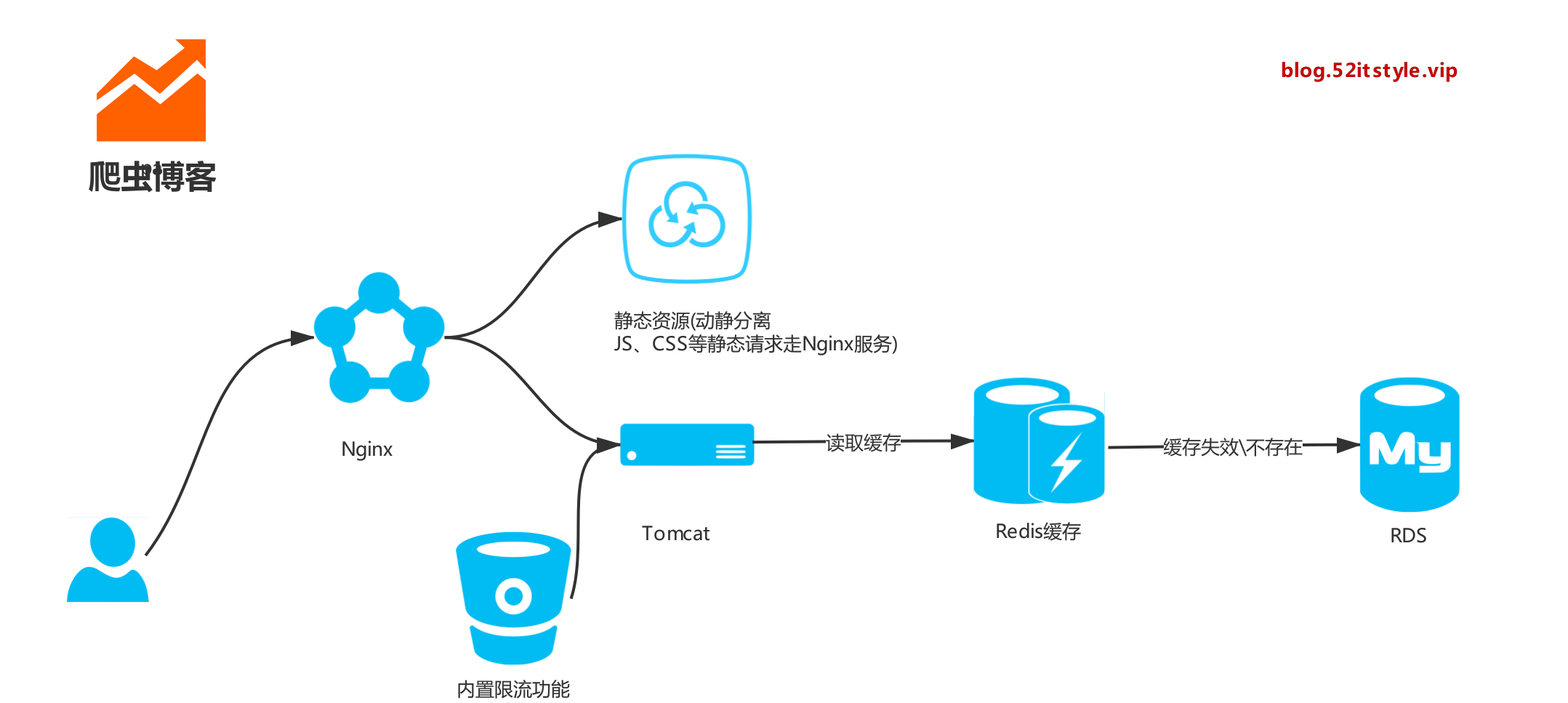SpringBoot开发案例之打造十万博文Web篇
- 2019 年 10 月 3 日
- 筆記

前言
通过 Python 爬取十万博文之后,最重要的是要让互联网用户访问到,那么如何做呢?
选型
从后台框架、前端模板、数据库连接池、缓存、代理服务、限流等组件多个维度选型。
- 后台框架 SpringBoot2+、JPA
- 前端框架 Vue
- 模块框架 Thymeleaf
- 数据库连接池 HikariCP
- 缓存 Redis
- 限流 Guava
- 代理服务 Nginx
- 文章编辑 Markdown
架构

博文
我们可以通过以下方式访问:
https://blog.52itstyle.top/49.html亦或是:
https://blog.52itstyle.top/49.shtml当然,如果你愿意你也可以显示为:
https://blog.52itstyle.top/49.php https://blog.52itstyle.top/49.asp https://blog.52itstyle.top/49.jsp只需要在后台配置对应的映射关系即可:
/** * 博文 */ @RequestMapping("{id}.html") public String blog(@PathVariable("id") Long id, ModelMap model) { Blog blog = blogService.getById(id); model.addAttribute("blog",blog); return "article"; }由于数据库存储的是 markedown 格式的数据,前台我们通过 editormd 转为 html 代码显示,这里只展示部分代码:
<script type='text/javascript' src='js/jquery.min.js'></script> <!--省略部分代码--> <script type='text/javascript' src="editor/editormd.min.js"></script> <!--省略部分代码--> <div id="article"> <textarea th:text="${blog.content}" style="display:none;" placeholder="markdown语言"> </textarea> </div> <!--省略部分代码--> <script> editormd.markdownToHTML("article", { htmlDecode : "style,script,iframe", emoji : true, taskList : true, tex : true, // 默认不解析 flowChart : true, // 默认不解析 sequenceDiagram : true // 默认不解析 }); </script>缓存
爬取的博文一般、基本、大概不会修改,所以我们完全可以缓存起来,避免跟数据库直接交互,顺便提升一下访问速速。正好手头有个 256MB 的阿里云 Redis 服务,拿来就用了。
首相引入以下组件:
<dependency> <groupId>org.springframework.boot</groupId> <artifactId>spring-boot-starter-cache</artifactId> </dependency> <dependency> <groupId>org.springframework.boot</groupId> <artifactId>spring-boot-starter-data-redis</artifactId> </dependency>配置 redis:
spring.redis.database=1 spring.redis.host=r-m5e4873fd882de14.redis.rds.aliyuncs.com spring.redis.port=6379 spring.redis.password=6347888 spring.redis.pool.max-active=8 spring.redis.pool.max-wait=-1 spring.redis.pool.max-idle=8 spring.redis.pool.min-idle=0 spring.redis.timeout=3000ms spring.cache.type = redis接口实现,引入 Cacheable 注解:
@Override @Cacheable(cacheNames ="blog") public Blog getById(Long id) { String nativeSql = "SELECT * FROM blog WHERE id=?"; return dynamicQuery.nativeQuerySingleResult(Blog.class,nativeSql,new Object[]{id}); }配置完成之后,我们打开数据库配置,多次访问博文地址,如果只是初次打印 SQL 说明配置成功:
spring.jpa.show-sql = true限流
万一哪天流量暴涨亦或是有人恶意攻击,尔等小服务器根本扛不住,所以有时候我们需要一定的手段进行限流,比如限制IP访问的频率次数。
这里我们使用开源的第三方组件库,引入以下组件:
<dependency> <groupId>com.google.guava</groupId> <artifactId>guava</artifactId> <version>25.1-jre</version> </dependency>自定义注解:
/** * 自定义注解 限流 */ @Target({ElementType.PARAMETER, ElementType.METHOD}) @Retention(RetentionPolicy.RUNTIME) @Documented public @interface ServiceLimit { /** * 描述 */ String description() default ""; /** * key */ String key() default ""; /** * 类型 */ LimitType limitType() default LimitType.CUSTOMER; enum LimitType { /** * 自定义key */ CUSTOMER, /** * 根据请求者IP */ IP } }限流逻辑:
/** * 限流 AOP */ @Aspect @Configuration public class LimitAspect { //根据IP分不同的令牌桶, 每天自动清理缓存 private static LoadingCache<String, RateLimiter> caches = CacheBuilder.newBuilder() .maximumSize(1000) .expireAfterWrite(1, TimeUnit.DAYS) .build(new CacheLoader<String, RateLimiter>() { @Override public RateLimiter load(String key){ // 新的IP初始化 每秒只发出5个令牌 return RateLimiter.create(5); } }); //Service层切点 限流 @Pointcut("@annotation(com.itstyle.blog.common.limit.ServiceLimit)") public void ServiceAspect() { } @Around("ServiceAspect()") public Object around(ProceedingJoinPoint joinPoint) { MethodSignature signature = (MethodSignature) joinPoint.getSignature(); Method method = signature.getMethod(); ServiceLimit limitAnnotation = method.getAnnotation(ServiceLimit.class); ServiceLimit.LimitType limitType = limitAnnotation.limitType(); String key = limitAnnotation.key(); Object obj; try { if(limitType.equals(ServiceLimit.LimitType.IP)){ key = IPUtils.getIpAddr(); } RateLimiter rateLimiter = caches.get(key); Boolean flag = rateLimiter.tryAcquire(); if(flag){ obj = joinPoint.proceed(); }else{ throw new RrException("小同志,你访问的太频繁了"); } } catch (Throwable e) { throw new RrException("小同志,你访问的太频繁了"); } return obj; } }收录
完事具备,就差被搜索引擎收录了,我们可以通过手动生成网站地图,提交给百度。
/** * 生成地图 * 参见:https://blog.52itstyle.top/sitemap.xml */ @Component public class SitemapTask { @Autowired private DynamicQuery dynamicQuery; protected Logger logger = LoggerFactory.getLogger(getClass()); @Value("${blog.url}") private String blogUrl; //每天23点执行一次 @Scheduled(cron = "0 0 23 * * ?") public void createSitemap() { logger.info("定时提交百度收录开始"); StringBuffer xml = new StringBuffer(); xml.append("<?xml version='1.0' encoding='utf-8'?>n"); xml.append("<urlset>n"); String nativeSql = "SELECT id,create_time FROM blog"; List<Object[]> list = dynamicQuery.query(nativeSql,new Object[]{}); list.forEach(blog -> { String url = blogUrl+blog[0]+".html"; xml.append(" <url>n"); xml.append(" <loc>"+url+"</loc>n"); xml.append(" <lastmod>"+blog[1]+"</lastmod>n"); xml.append(" </url>n"); }); xml.append("</urlset>n"); saveAsFileWriter(xml.toString()); logger.info("定时提交百度收录结束"); } private static void saveAsFileWriter(String content) { String path = ClassUtils.getDefaultClassLoader().getResource("").getPath(); String filePath = path + "static"+ SystemConstant.SF_FILE_SEPARATOR+"sitemap.xml"; FileWriter fwriter = null; try { fwriter = new FileWriter(filePath, false); fwriter.write(content); } catch (IOException ex) { ex.printStackTrace(); } finally { try { fwriter.flush(); fwriter.close(); } catch (IOException ex) { ex.printStackTrace(); } } } } 打包
尽量不要以Jar包形式部署,为了以后方便部署,最好放置到 外置Tomcat 下。
pom.xml 中移除内置 Tomcat:
<dependency> <groupId>org.springframework.boot</groupId> <artifactId>spring-boot-starter-tomcat</artifactId> <scope>provided</scope> </dependency>修改启动类:
/** * 启动类 * 创建者 科帮网 * 创建时间 2019年7月21日 */ @SpringBootApplication @EnableCaching @EnableScheduling public class Application extends SpringBootServletInitializer { private static final Logger logger = LoggerFactory.getLogger(Application.class); public static void main(String[] args) { SpringApplication.run(Application.class, args); logger.info("项目启动"); } @Override protected SpringApplicationBuilder configure(SpringApplicationBuilder application) { return application.sources(Application.class); } }代理
项目部署后,最好加一层代理服务,这里我们使用Nginx:
server { listen 80; server_name blog.52itstyle.top; return 301 https://$server_name$request_uri; } server{ listen 443 ssl; server_name blog.52itstyle.top; #证书路径 ssl_certificate /usr/local/openresty/nginx/cert/2543486_blog.52itstyle.top.pem; #私钥路径 ssl_certificate_key /usr/local/openresty/nginx/cert/2543486_blog.52itstyle.top.key; #缓存有效期 ssl_session_timeout 5m; #可选的加密算法,顺序很重要,越靠前的优先级越高. ssl_ciphers ECDHE-RSA-AES128-GCM-SHA256:ECDHE:ECDH:AES:HIGH:!NULL:!aNULL:!MD5:!ADH:!RC4; #安全链接可选的加密协议 ssl_protocols TLSv1 TLSv1.1 TLSv1.2; ssl_prefer_server_ciphers on; location = /500.html { root /usr/local/openresty/nginx/html; } error_page 500 502 503 504 = /503/503.html; location / { proxy_pass http://127.0.0.1:8080; } location ~ /.ht { deny all; } }动静分离,将静态文件交由Nginx处理,加速博客访问:
#静态文件交给nginx处理 location ~ .*.(js|css|gif|jpg|jpeg|png|bmp)?$ { root /home/tomcat8/webapps/ROOT/WEB-INF/classes/static; expires 2h; }源码:https://gitee.com/52itstyle/Python
列表:https://blog.52itstyle.top/index
详情:https://blog.52itstyle.top/49.shtml
小结
撸完整个项目,基本能接触的都用上了,前后端框架、连接池、限流、缓存、动静分离,HTTPS安全认证、百度收录等等,特别适合有一定开发基础的小伙伴!
源码
https://gitee.com/52itstyle/spring-boot-blog
